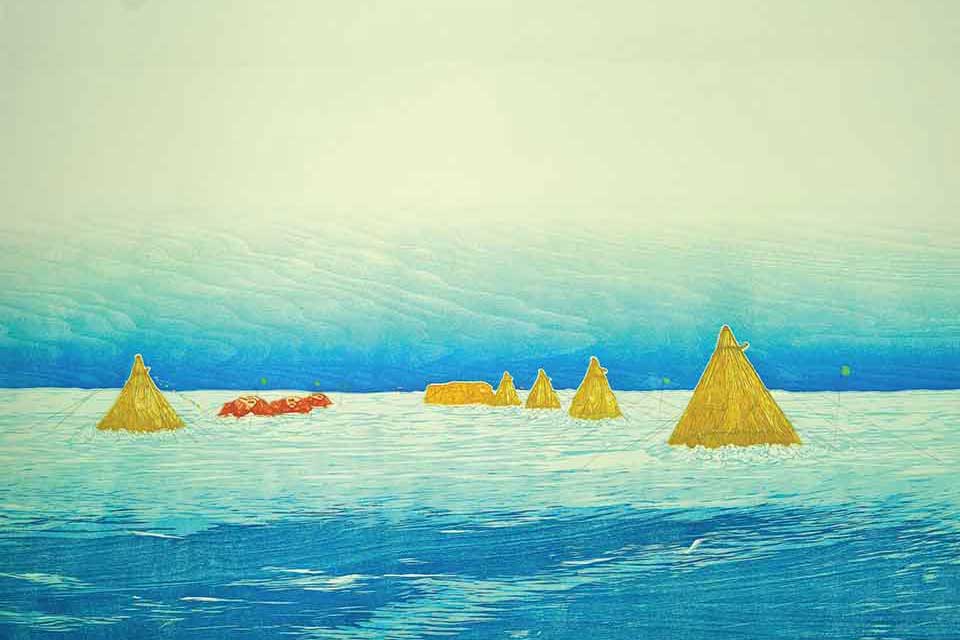Dispatches from the Ice

In 2019 Todd Anderson journeyed to the Allan Hills with fellow artist Ian van Coller to visit and document an eight-person ice coring science team led by Princeton University professor and geoscientist John Higgins. Additional Allan Hills team members included Austin Carter (Scripps UC–San Diego), Jenna Epifanio (Oregon State University), Jacob Morgan (Scripps UC–San Diego), Sarah Shackleton (Princeton University), drill operators Tanner Kuhl and Elizabeth Morton (University of Wisconsin–Madison), and USAP camp coordinator Anna Zajicek.
Journal Entry, 19 November 2019: Arrival at Allan Hills blue ice area
. . . This is the farthest afield I will ever be
—visually and geographically.
Reflecting on this journal entry now in 2022, I am reminded that definitive statements about the future rarely hold up. But sometimes they do. Earlier in 2019, I hiked amongst glaciers in the Rwenzori Mountains of Uganda and a month later north of the Arctic Circle to the Penny Ice Cap on Baffin Island in Nunavut, Canada. I found the Rwenzori Mountain Range unworldly in its beauty; had an emergency arisen while traveling on the Penny Ice Cap—three days’ wait for a rescue was the best I could have hoped for. On both of these expeditions I felt moments of wonder and physical caution that seemed absolute. When I wrote the above journal entry, I had just arrived at the Allan Hills blue ice area, which is part of the East Antarctic Ice Sheet. I was approximately 675 miles north of the South Pole and 135 miles from the nearest medical services at McMurdo Station, the United States’ premier Antarctic research center.
My initial experience with the landscape at Allan Hills was akin to feeling adrift in an ocean of ice. There was a seemingly endless horizon to behold there, and the magnitude of the expanse allowed my eyes to discern a slight bend in the horizon line as it adhered to the earth’s spherical shape. Owing to exceedingly low levels of atmospheric humidity, visual clarity in Antarctica is unrivaled. Unaided, one can see for hundreds of miles. And what I saw was a tremendously vast plane of cerulean blue ice canopied by a similarly hued sky. There was a steady, southern wind coming from the pole that day. I would soon learn that even on relatively calm days a strength of wind is not just felt but always heard in the Allan Hills. Above all else, though, the Allan Hills is an extremely cold place. Rarely does the temperature rise above fifteen degrees Fahrenheit, while subzero temperatures are the norm. Within days of my arrival, it hit negative twenty degrees Fahrenheit. I began using three chemical heat warmers in each boot—one under the sole of the foot and one above and one below the toes. I had never seen or been to any place quite like this.
Journal Entry, 24 November 2019: Day 6, Higgins Ice Coring Tent, Allan Hills
. . . Earth breathes in and out
—remember carbon dioxide.
The Allan Hills is one of the few spots in Antarctica where intense katabatic winds (wind generated by gravity) from the interior of East Antarctica prevent the accumulation of new snow on the ground. When the area’s fierce katabatic winds are combined with its tremendously dry atmosphere and severely cold temperatures, ice and snow transition from a solid state directly to a gas (altogether bypassing a liquid state, a process called sublimation). Put simply, any type of precipitation or snow in the Allan Hills either evaporates instantly before touching the ground or is disappeared elsewhere by the wind.
When ice is formed, air bubbles and dust become trapped. Under analysis, ice bubbles can relay physical records such as the concentrations of atmospheric greenhouse gases, like carbon dioxide (CO2) and methane (CH4), from when the ice formed. Examination of trapped dust similarly helps scientists understand past planetary events and conditions (such as dates of volcanic eruptions and weather patterns). While ice coring can be conducted anywhere ice of a modest depth can be found, the Allan Hills blue ice area is special because it contains some of the oldest ice ever discovered on the planet. Owing to sublimation and surface-scouring katabatic winds, the Allan Hills’ surface-level ice is already about one hundred thousand years old and only gets older the deeper one drills. Combined with a rare, below-ice geologic bedrock formation (which incrementally turns and pushes older ice upward toward the surface), scientists need only to drill relatively short depths in the Allan Hills to attain ice cores dating back upwards of ~2.7 million years. When chronologically dated and analyzed, ice cores can reveal surprisingly accurate decadal to millennial worths of information about the planet’s past.
The Allan Hills blue ice area is special because it contains some of the oldest ice ever discovered on the planet.
What does ancient ice reveal? To begin, ice analysis reveals how the planet’s climate has varied cyclically over the last 2.5 to 3 million years, somewhat akin to the earth breathing differing levels of carbon dioxide at an epochal pace. Second, Allan Hills ice cores tell us that not since this time, about 3 million years ago, have planet Earth’s CO2 levels been >400ppm, which are currently at 418.19ppm (monthly average mean, January 2022, NOAA Global Monitoring Laboratory). Additionally, ice cores provide definitive evidence that atmospheric carbon dioxide levels and Earth’s temperature are directly linked. Scientist can concretely corollate events such as human industrialization periods (and even specific years when certain aerosol restriction policies were put into effect) with changes in CO2 levels and global temperatures. In summation, the global climate crisis can no longer be comprehended as theoretical nor its human-induced source debatable. Its threats to the furtherance of humanity are definitive.
Clemson, South Carolina











